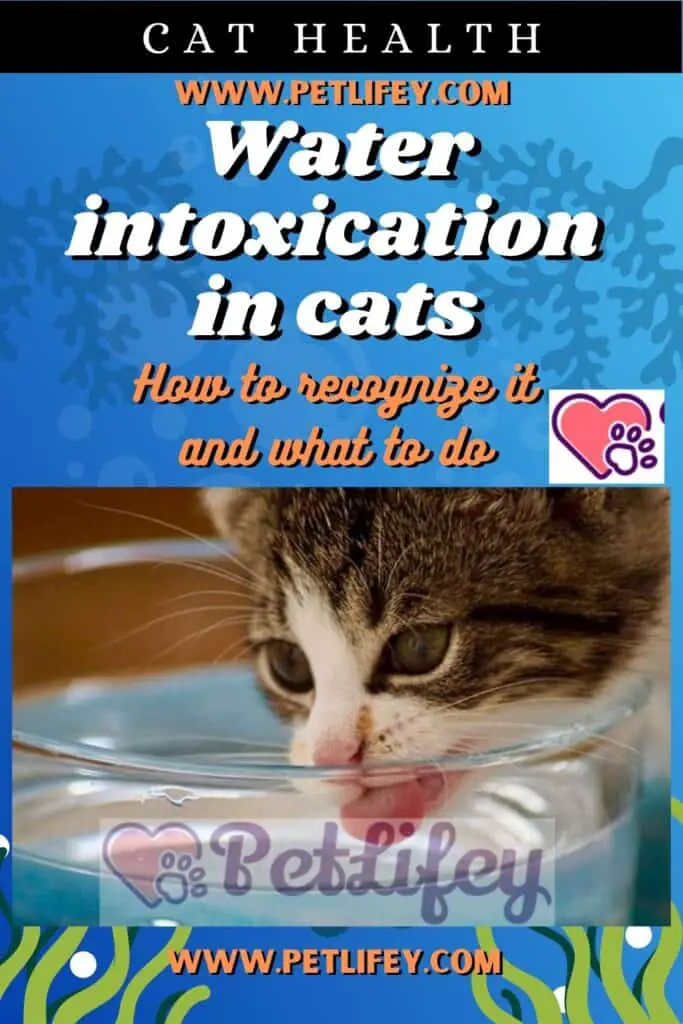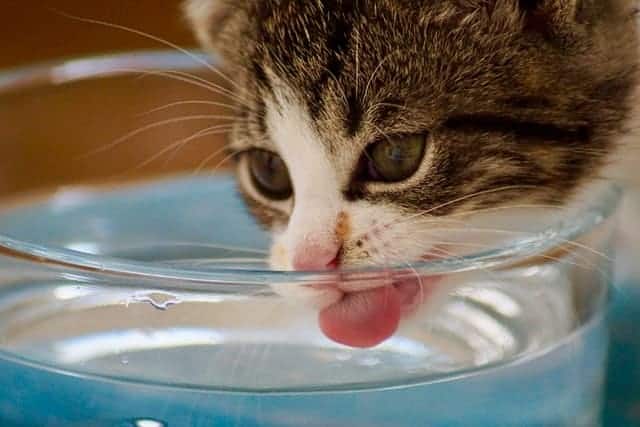
A cat who drinks too much water can have problems that should not be underestimated. How to recognize water poisoning in cats and what to do?
When the weather gets warmer, our cat will likely want to drink more water. However, sometimes, if your kitty is drinking a lot, it could signal an underlying problem. Previously, we talked about the possible actions to take if our cat does not drink enough water, as well as how to avoid and treat dehydration. A less common (but still dangerous) situation occurs when a cat starts drinking more water. But not only that: water intoxication in cats can occur when a pet has been on the beach or in the pool, and therefore in contact with unsafe water.
Recognizing water poisoning in cats
Acute water poisoning is not common, and generally occurs during the warmer months when a cat has been in the pool or on the beach. Let’s make sure we know what to look for, and the best next steps to take if your cat has this problem. Initially – and in milder cases – clinical signs may include nausea, vomiting, lethargy, and abdominal distension. In severe cases, ataxia, weakness, coma, convulsions, hypothermia and bradycardia can occur.
If the cat has been drinking sea water, however, it may not have a problem. If we humans tried to drink only sea water, we would die of dehydration. Instead, cats can drink sea water and have no problem surviving! This is because their kidneys are efficient enough to filter out the salt and use desalinated seawater for hydration. It is obviously not recommended to give the cat salt water.
But what are the possible health problems in a cat that drinks too much? In the medical field, drinking excessive amounts of water is known as polydipsia. There is a link between numerous polydipsia diseases. Some of the most common are:
- Diabetes. Excessive thirst is one of the first signs of diabetes in cats, and is usually accompanied by sudden weight loss, which is soon replaced by weight gain. It is a very specific model. Even if there are no other symptoms of diabetes, such as excessive urination and increased appetite, a veterinary visit is mandatory.
- Kidney failure. Other signs that may be present are diarrhea and vomiting. Symptoms include blood in stool and vomit, lethargy, anorexia, and a few others.
- Hyperthyroidism. This is very common in cats. Additional signs to look for are weight loss, increased appetite, vomiting, diarrhea, poor body condition, and an enlarged thyroid .
There may be other health conditions linked to increased water consumption in cats (and dogs too). But it is not relevant. The most important point to note is this: if our cat drinks too much, we need to take him to the vet immediately. Any of the aforementioned diseases can be managed or treated efficiently if diagnosed early.
How to tell if the cat drinks too much
To understand if our cat drinks too much and therefore we risk water poisoning in the cat, of course, we must monitor how much water he drinks. Let’s not just replace and add water to the cat’s bowl, but let’s measure how much water the bowl contains and pay attention to how much it reduces during the day.
But how much water should a cat drink and how much is too much? According to veterinarians, polydipsia is higher than normal water consumption; that is, more than 45 ml per kg per day (this quantity also includes the water that the cat receives in its food). For example, if a cat weighs 5 kg (an average body), its daily water requirement is 225 ml.
Sure, excessive water consumption can lead to water poisoning in cats, but it’s not easy to figure out the exact amount cats should drink each day. Each cat is different and each will drink different amounts depending on their lifestyle, health and environmental factors. For example, a cat who lives inside a cool house may not drink as much as a very active cat who spends a lot of time outside .
Keep in mind that a lot of our cat’s water intake could come from their food. Wet cat food already contains some water, so a cat who has a wet diet won’t have to drink as much as a cat who eats only dry food. Our cat should instinctively know that he needs more water and should drink enough to compensate – after all, he is just as thirsty as we are. There are many other factors that will affect the amount of water consumed. Like us, cats will drink more if it’s hot or if they’ve been physically very active, so let’s take these things into consideration.
As mentioned above, the amount we are talking about also includes the water our cat gets in their food. Most dry foods contain no more than 10% moisture, while canned foods can contain more than 80% water; therefore, a cat’s diet choice can significantly alter how much he should drink.
Here are the approximate amounts of water provided by daily amounts of dry and wet food:
- 50g of dry food provides 5ml of water, which means our example cat needs to drink another 220ml of water. It’s almost a full cup.
- 240g of wet food provides 192ml of water: Therefore, a cat should only drink 33ml of water per day. This amount is slightly more than 2 tablespoons, which is very, very little.
But let’s not get lost in the calculations. It is best if we can follow our cat’s water consumption habits over the long term, and be alert if they start to change. In case we notice that our pet is drinking more water than usual recently, let’s take him to a vet. An early response can take us many steps forward from the starting line when we have to fight for the health of our furry friend.
Signs of increased drinking
It can be difficult to keep an eye on our cat’s water intake. After all, we can’t watch it every minute of the day, and if we have more than one animal it’s nearly impossible to tell who is eating and drinking what!
So, if we can’t measure the amount of liquid our cat is drinking, we can look for other signs that show our pet is drinking a lot more than usual. The three main ones are:
- He makes more trips to the water bowl than usual
- You need to refill the water bowl more often
- He drinks from unusual places, such as taps or ponds , if he has never done so before. In fact, many cats do this anyway, so if it’s normal behavior for our cat, we don’t need to worry!
How to tell if the cat is not well? It’s not easy, because most cats are very good at hiding disease, so an increase in thirst may be the first sign we notice. If we think the cat is drinking a lot more than usual, pay attention to these other common signs:
- Changes in appetite: Eat more or less than usual
- Behavior changes – for example, being aggressive when your cat is usually calm
- Changes in sleep patterns – particularly if you sleep a lot, or in unusual places
- Illness or diarrhea
If our cat drinks a lot of water and shows other signs of illness, he should be checked and diagnosed by a veterinarian. In particular, excessive thirst in cats can be a symptom of: nephropathy, diabetes melito, hyperthyroidism or urinary tract disease.
What to do if the cat is drinking a lot

If our cat is drinking excessively and has no other unusual symptoms, let’s try to think about the cause. Is our house very hot? Is he only eating dry food? Has your drinking increased because it’s summer? If we can clearly reduce our cat’s excessive consumption to an environmental factor, it is enough to keep an eye on his health and behavior in general.
As long as our cat is healthy and happy, and gets plenty of fresh water when he wants it, he should be fine. We could take note and ask the vet at the next check-up for some information, if only to remove any doubts. If, on the other hand, our cat seems not to be well, we bring to a visit to the vet as soon as possible. We remember to explain that the cat has been drinking a lot, and we point out any other unusual symptoms. Your doctor will be able to diagnose and find a possible treatment for you.






